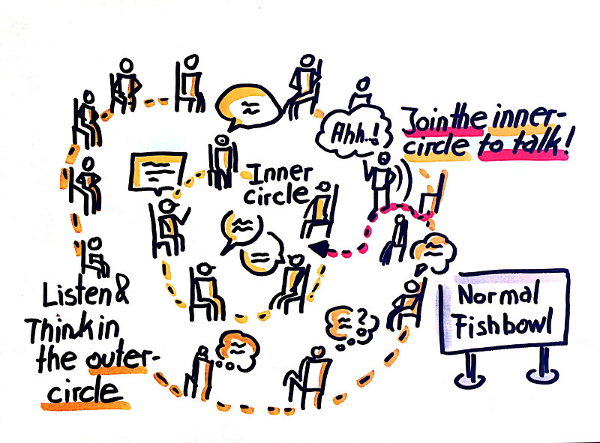Fishbowl conversation
Fishbowls are useful for debating “hot topics” or sharing ideas or information from a variety of perspectives.

Quote
The conversation takes place in the inner circle, and those seated in the outer circle observe. If the observers want to join the inner circle they may occupy the empty chair and one of the inner circle attendees leaves.
Sometimes a prop can be used to manage the conversation, for example, the person holding the fish will be the speaker. Fishbowl conversations can either be closed (where the inner circle contains experts, and don’t change) or open, (where people from the outer circle join the inner circle).
Rules
- The following topic is proposed for the discussion: “NHS libraries should provide library services directly to patients.”
- The inner circle: the conversation will be started by 3-4 people (you can give them prompt cards to start). Examples can be seen below
- Start with an argument in favour of delivering library services to patients followed by an argument against it
- How would patients benefit?
- What is the evidence that patients want to use the service?
- Do the public need to come into the Library to access services?
- Does anyone have any ideas about providing information for patients without inviting them into the Library?
- Do you need to upskill NHS Library and Knowledge Service (LKS) staff to deal with patients?
- Do you need to provide resources [for example, books, journals] as well as the internet?
- Should we specify what services they can or can’t use?
- The outer circle: If you want to join the conversation, or would like to pose a question, join the inner circle
- When a new person joins the inner circle, someone should leave
- We will try using a fish to manage the conversation – when you have the fish, you have the floor and can speak
- Outer circle: if you don’t want to join in, you might want to take notes
- The facilitators will capture the conversation and will make room in the inner circle if needed
- After observing or participating in the conversation, have a group discussion about the conversation points raised
- Make sure all discussion is captured
Acknowledgement to Victoria Treadway and Tracey Pratchett for sharing this exercise.
More information
This postcard described the Fishbowl tool in words and pictures.
Contact the Knowledge for Healthcare team for the postcard in an accessible format.
Page last reviewed: 25 August 2023
Next review due: 25 August 2024